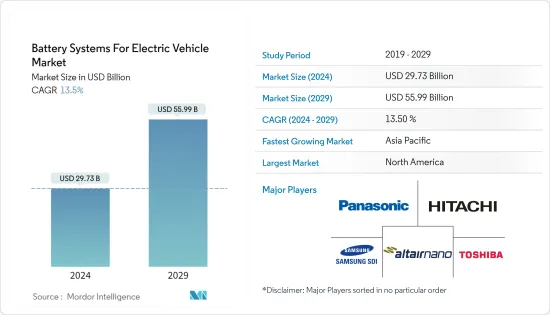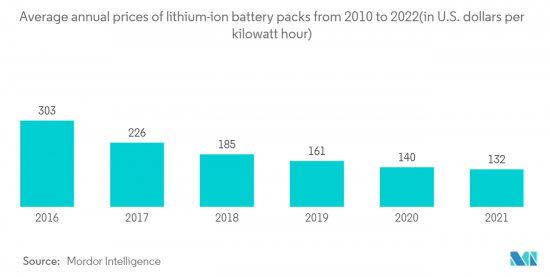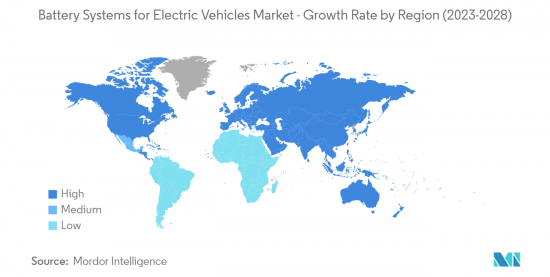 |
市場調査レポート
商品コード
1429218
電気自動車用バッテリーシステム:市場シェア分析、産業動向・統計、成長予測(2024~2029年)Battery Systems For Electric Vehicle - Market Share Analysis, Industry Trends & Statistics, Growth Forecasts (2024 - 2029) |
||||||
● お客様のご希望に応じて、既存データの加工や未掲載情報(例:国別セグメント)の追加などの対応が可能です。 詳細はお問い合わせください。
| 電気自動車用バッテリーシステム:市場シェア分析、産業動向・統計、成長予測(2024~2029年) |
|
出版日: 2024年02月15日
発行: Mordor Intelligence
ページ情報: 英文 90 Pages
納期: 2~3営業日
|
- 全表示
- 概要
- 目次
電気自動車用バッテリーシステム市場規模は、2024年に297億3,000万米ドルと推定され、2029年には559億9,000万米ドルに達すると予測され、予測期間(2024-2029年)のCAGRは13.5%で成長します。

主なハイライト
- COVID-19パンデミックは、電気自動車用バッテリーシステム市場にかつてない課題をもたらしました。封鎖措置と渡航制限が世界のサプライチェーンを混乱させ、電池生産の遅延と不足につながった。製造施設と原材料のサプライチェーンが影響を受け、電気自動車の入手可能性と価格に影響を与えました。経済の不確実性、個人消費の減少、移動の制限により、電気自動車の販売台数は大幅に減少しました。この落ち込みはバッテリーシステム市場に直接影響を与えました。
- COVID後の電気自動車用バッテリーシステム市場は、いくつかの要因によって回復し、成長軌道を再開しました。世界各国の政府は引き続き脱炭素化と持続可能な輸送を優先しています。電気自動車の普及を促進するために、景気刺激策や支援政策が実施される可能性が高く、これがバッテリーシステムの需要を促進します。
- 世界経済が回復し規制が緩和されれば、電気自動車の需要も回復すると予想されます。消費者の持続可能性と環境意識への関心の高まりは、バッテリー・システム市場の成長に寄与すると思われます。継続的な研究開発努力により、エネルギー密度の向上、充電能力の高速化、航続距離の延長など、バッテリー技術の進歩が見込まれます。こうした進歩は電気自動車の性能と魅力を高め、バッテリー・システムの需要を促進します。
- バッテリー式電気自動車は、車載バッテリーに蓄えられた電気を動力源としています。電気自動車に使用される車載バッテリーは、ニッケル水素、鉛酸、リチウムイオンの3種類のいずれかに分類されます。バッテリー電気自動車に搭載された二次電池パックに蓄えられた化学エネルギーは、電気モーターとモーターコントローラーを駆動します。
- 中国、米国、日本を含む先進国の主要政府は電動モビリティへの投資を進めており、電気自動車用バッテリー・システム市場に大きな成長機会をもたらすと思われます。予測期間中、アジア太平洋と北米が市場を独占する可能性が高いです。
電気自動車用バッテリーシステム市場の動向
バッテリーの高コストと走行距離の制限が市場成長の妨げに
- 政府の補助金やインセンティブなど、いくつかの要因が世界のバッテリー式電気自動車市場を牽引しています。多くの国の政府は、バッテリー電気自動車の購入者に金銭的なインセンティブという形で恩恵を与えています。こうした奨励金の額は通常、バッテリーのサイズによって異なります。
- 例えば、アイルランドのthe Sustainable Energy Authority of Ireland(SEAI)はバッテリー電気自動車の購入者に最大5,400米ドルの補助金を支給し、自動車登録税を免除しています。電気自動車市場におけるバッテリーの成長にもかかわらず、いくつかの深刻な課題によって抑制されています。
- 電気自動車のバッテリーの航続距離と性能は、市場にとって大きな抑制要因です。バッテリーは一般的にパワーが弱く、航続距離も限られている(1回の充電で60~100マイル)ため、短距離の移動にしか適していないと考えられています。電気自動車のバッテリーは走行距離が限られているため、目的地に到着する前に充電切れ・電力切れになるのではないかという懸念が消費者の間に広がっています。
- 充電時間が長いことも、市場にとって大きな課題です。スーパーチャージング・ステーションが利用できないことも、電気自動車のバッテリー使用に関連する悩みに拍車をかけています。電気自動車に搭載されるバッテリーのコストが高いことも、特にバッテリー市場とバッテリー式電気自動車全般の成長に脅威を与えています。例えば、リチウムイオンバッテリーの使用可能キロワット時当たりの価格は500米ドルから650米ドルであるため、車両コストの大きな割合を占めています。

成長が加速するアジア太平洋市場
アジア太平洋地域は、電気自動車用バッテリーシステム市場において急速な成長を遂げています。同地域がこの分野で存在感を増している背景には、いくつかの要因があります。中国、日本、韓国などの国々では、電気自動車の販売台数が大幅に増加しています。これらの国々は、支援政策、補助金、インフラ整備を通じて電気自動車の採用を積極的に推進しています。アジア太平洋地域における電気自動車需要の高まりは、先進的なバッテリー・システムの必要性を高めています。
- 例えば、2023年5月、中国の自動車メーカーJACグループとハイテク企業HiNa Batteryが提携し、ナトリウムイオン電池を搭載した電気自動車を開発しました。
さらに、アジア太平洋地域は電気自動車とその部品の主要製造拠点として浮上しています。この地域は強固なサプライ・チェーンと熟練した労働力を誇り、バッテリーシステム・メーカーにとって魅力的な進出先となっています。現地生産により生産コストが削減され、効率的な流通が可能になります。アジア太平洋地域には、革新的なバッテリー技術企業や研究機関がいくつかあります。これらの企業は、より高いエネルギー密度、より改善された安全性、より高速な充電機能を備えた先進的なバッテリーシステムの開発に専念しています。研究開発に重点を置くことでイノベーションが促進され、この地域はバッテリーシステムの進歩の最前線に位置しています。
さらに、アジア太平洋地域の政府は、持続可能な輸送目標を達成するための電気自動車とバッテリーシステムの可能性を認識しています。これらの政府は、国内のバッテリー製造と研究を促進するために、財政的インセンティブ、補助金、助成金を提供しています。こうした取り組みが、同地域のバッテリーシステム市場の成長を加速させています。アジア太平洋地域では、道路を走る電気自動車の増加に対応するため、充電インフラの整備に投資しています。各国政府は民間企業と協力して充電ステーションを設置し、航続距離への不安に対処して電気自動車体験全体を向上させるためにスマートグリッドソリューションを導入しています。こうしたインフラ整備は、バッテリーシステムの需要をさらに押し上げています。
これらの要因を考慮すると、アジア太平洋地域は他の地域と比較して、電気自動車用バッテリーシステム市場の成長ペースが速いと予想されます。電池メーカー、サプライヤー、利害関係者にとっては、急成長する電気自動車市場を活用する大きなチャンスとなります。

電気自動車用バッテリーシステム産業概要
主要ベンダーには、Samsung SDI、Toshiba Corporation、BYD、Panasonic Corporationなどが含まれます。現在、電気自動車用電池メーカーは、放電時間を長くするために電池の化学的性質を改善する研究開発に投資しています。
リチウムイオン電池の技術的進歩により、従来の鉛蓄電池やバルブ制御鉛蓄電池(VRLA)電池に比べて比較的軽量で寿命が長くなっています。バッテリー式電気自動車が内燃機関車に代わる最も現実的な選択肢となりつつあり、排ガス問題の解決策にもなっていることから、この種の自動車の需要は予測期間中に大幅に増加すると予想され、電気バッテリー・メーカーにとっては絶好の機会となっています。
例えば、スイスの新興企業Morand社は、電気自動車の充電時間を約72秒に大幅に短縮する画期的なバッテリー技術を発表しました。同社の革新的なEV用バッテリーは、従来のバッテリー技術とウルトラキャパシター技術を巧みに組み合わせたハイブリッド・システムを採用しており、その名も「eテクノロジー」です。この先駆的なアプローチにより、電気自動車はわずか72秒で80%の驚異的な充電を達成し、わずか2分半で100%のフル充電を完了することができます。
その他の特典:
- エクセル形式の市場予測(ME)シート
- 3ヶ月間のアナリスト・サポート
目次
第1章 イントロダクション
- 調査の前提条件
- 調査範囲
第2章 調査手法
第3章 エグゼクティブサマリー
第4章 市場力学
- 市場促進要因
- 世界各国政府は、電気自動車の普及を促進するために厳しい規制を実施し、インセンティブを提供
- その他
- 市場抑制要因
- 高いイニシャルコスト
- その他
- 業界の魅力- ポーターのファイブフォース分析
- 新規参入業者の脅威
- 買い手/消費者の交渉力
- 供給企業の交渉力
- 代替品の脅威
- 競争企業間の敵対関係の強さ
第5章 市場セグメンテーション
- 種類
- リチウムイオン電池
- ニッケル水素電池
- 鉛蓄電池
- ウルトラキャパシタ
- その他
- 車両タイプ
- 乗用車
- 商用車
- 地域
- 北米
- 米国
- カナダ
- メキシコ
- その他北米地域
- 欧州
- ドイツ
- 英国
- フランス
- イタリア
- その他欧州
- アジア太平洋
- 中国
- 日本
- インド
- オーストラリア
- その他アジア太平洋地域
- 南米
- ブラジル
- アルゼンチン
- その他南米
- 中東・アフリカ
- アラブ首長国連邦
- サウジアラビア
- その他中東とアフリカ
- 北米
第6章 競合情勢
- ベンダー市場シェア
- 企業プロファイル
- A123 Systems LLC
- Altairnano
- Boston-Power, Inc.
- Hitachi, Ltd.
- Johnson Controls International PLC
- LG Chem
- NEC Corporation
- Panasonic Corporation
- Toshiba Corporation
- Samsung SDI Co Ltd
第7章 市場機会と今後の動向
- 長距離EVへの需要の高まり
- 持続可能性と環境への影響の重視
- EV充電インフラの成長
The Battery Systems For Electric Vehicle Market size is estimated at USD 29.73 billion in 2024, and is expected to reach USD 55.99 billion by 2029, growing at a CAGR of 13.5% during the forecast period (2024-2029).

Key Highlights
- The COVID-19 pandemic brought unprecedented challenges to the battery systems for the electric vehicles market. Lockdown measures and travel restrictions disrupted global supply chains, leading to delays and shortages in battery production. Manufacturing facilities and raw material supply chains were affected, impacting the availability and affordability of electric vehicles. Economic uncertainty, reduced consumer spending, and mobility restrictions resulted in a significant decline in electric vehicle sales. This decline directly impacted the battery systems market.
- The battery systems for electric vehicles market recovered and resumed its growth trajectory post-COVID due to several factors. Governments worldwide continue to prioritize decarbonization and sustainable transportation. Stimulus packages and supportive policies are likely to be implemented to boost the adoption of electric vehicles, which will drive the demand for battery systems.
- As the global economy recovers and restrictions ease, the demand for electric vehicles is expected to rebound. Consumers' increased focus on sustainability and environmental consciousness will contribute to the growth of the battery systems market. Continued research and development efforts will lead to advancements in battery technologies, including higher energy densities, faster charging capabilities, and longer ranges. These advancements will enhance the performance and attractiveness of electric vehicles, driving the demand for battery systems.
- Battery electric vehicles are powered by the electricity stored in the onboard battery. The onboard battery used in electric vehicles can be classified under one of the following three types: nickel metal hydride, lead-acid, and lithium-ion. The chemical energy stored in rechargeable battery packs installed in battery electric vehicles propels the electric motors and motor controllers.
- Major governments across developed countries, including China, the United States, and Japan, are investing in electric mobility, which is likely to provide significant growth opportunities for the battery system for electric vehicle market. Asia-Pacific and North America are likely to dominate the market during the forecast period.
Battery Systems for Electric Vehicles Market Trends
High Cost of Battery and Limited Driving Range Hindering the Market Growth
- Several factors, such as government subsidies and incentives, drive the global battery electric vehicles market. Governments in many countries have extended benefits in the form of financial incentives to the buyers of battery electric vehicles. The amount of these incentives usually depends on the size of the battery.
- For instance, the Sustainable Energy Authority of Ireland (SEAI) provides buyers of battery electric vehicles with grants of up to USD 5,400 and exempts them from vehicle registration tax. Despite the growth of the battery in the electric vehicles market, it is also curtailed by some serious challenges.
- The range and performance of the battery in electric vehicles are significant restraints for the market. The batteries are typically less powerful and have a limited range (60-100 miles per charge), and are considered suitable only for short-distance travel. The limited travel range of batteries of electric vehicles raises concerns among consumers that their vehicles may run out of charge/power before reaching their destination.
- Longer charging duration is another major challenge for the market. The lack of availability of supercharging stations adds to the woes associated with the use of batteries in an electric vehicle. The high cost of the battery in the electric vehicle also poses a threat to the growth of the battery market in particular and battery electric vehicles in general. For instance, the price per usable kilowatt-hour of a lithium-ion battery ranges from USD 500 to USD 650, and thus, makes up a large proportion of the vehicle's cost.

Asia-Pacific Market Growing at a Faster Pace
The Asia-Pacific region is indeed experiencing rapid growth in the battery systems for electric vehicles market. Several factors contribute to the region's increasing prominence in this sector. Countries like China, Japan, and South Korea have witnessed a substantial increase in electric vehicle sales. These nations are actively promoting the adoption of electric vehicles through supportive policies, subsidies, and infrastructure development. The rising demand for electric vehicles in the Asia-Pacific region drives the need for advanced battery systems.
- For instance, In May 2023, Chinese automaker JAC Group and tech company HiNa Battery teamed up to create an electric car powered by a sodium-ion battery.
Additionally, Asia-Pacific has emerged as a major manufacturing hub for electric vehicles and their components. The region boasts a robust supply chain and a skilled workforce, making it an attractive destination for battery system manufacturers. This localized manufacturing reduces production costs and allows for efficient distribution. The Asia-Pacific region is home to several innovative battery technology companies and research institutes. These entities are dedicated to developing advanced battery systems with higher energy density, improved safety, and faster charging capabilities. The emphasis on research and development fosters innovation and positions the region at the forefront of battery system advancements.
Moreover, governments in the Asia-Pacific region have recognized the potential of electric vehicles and battery systems in achieving sustainable transportation goals. They provide financial incentives, subsidies, and grants to promote domestic battery manufacturing and research. These initiatives accelerate the growth of the battery systems market in the region. The Asia-Pacific region is investing in the development of charging infrastructure to support the growing number of electric vehicles on the roads. Governments, in collaboration with private players, are establishing charging stations and implementing smart grid solutions to address range anxiety and enhance the overall EV experience. This infrastructure development further propels the demand for battery systems.
Considering these factors, the Asia-Pacific region is expected to witness a faster pace of growth in the battery systems for electric vehicles market compared to other regions. It offers significant opportunities for battery manufacturers, suppliers, and related stakeholders to capitalize on the burgeoning electric vehicle market.

Battery Systems for Electric Vehicles Industry Overview
The key vendors include Samsung SDI Co Ltd, Toshiba Corporation, BYD, and Panasonic Corporation, as they will be responsible for providing the automobile makers with the battery kit shortly. Currently, the battery manufacturers of electric vehicles are investing in R&D to improve the chemistry of the batteries to give a longer discharge time.
Technological advances in Li-ion batteries have made them comparatively lightweight with a long lifespan compared to conventional lead-acid and valve-regulated lead-acid battery (VRLA) batteries. With battery electric vehicles becoming the most viable alternative to ICE-powered automobiles and a solution to the problem of emissions, the demand for this type of vehicle is expected to increase considerably during the forecasted period, which calls for an excellent opportunity for electric battery manufacturers.
For instance, Swiss start-up Morand has introduced a groundbreaking battery technology that significantly reduces the charging time of electric vehicles to approximately 72 seconds. Their innovative EV battery utilizes a hybrid system, cleverly combining conventional battery technology with ultracapacitor technology, aptly named eTechnology. This pioneering approach allows electric vehicles to achieve an impressive 80% charge in a mere 72 seconds and complete a full 100% charge in just 2.5 minutes.
Additional Benefits:
- The market estimate (ME) sheet in Excel format
- 3 months of analyst support
TABLE OF CONTENTS
1 INTRODUCTION
- 1.1 Study Assumptions
- 1.2 Scope of the Study
2 RESEARCH METHODOLOGY
3 EXECUTIVE SUMMARY
4 MARKET DYNAMICS
- 4.1 Market Drivers
- 4.1.1 Governments worldwide are implementing strict regulations and providing incentives to promote the adoption of electric vehicles
- 4.1.2 Others
- 4.2 Market Restraints
- 4.2.1 High Initial Costs
- 4.2.2 Others
- 4.3 Industry Attractiveness - Porter's Five Force Analysis
- 4.3.1 Threat of New Entrants
- 4.3.2 Bargaining Power of Buyers/Consumers
- 4.3.3 Bargaining Power of Suppliers
- 4.3.4 Threat of Substitute Products
- 4.3.5 Intensity of Competitive Rivalry
5 MARKET SEGMENTATION
- 5.1 Type
- 5.1.1 Lithium-Ion Batteries
- 5.1.2 Nickel-Metal Hydride Batteries
- 5.1.3 Lead-Acid Batteries
- 5.1.4 Ultra capacitors
- 5.1.5 Others
- 5.2 Vehicle Type
- 5.2.1 Passenger Cars
- 5.2.2 Commercial Vehicles
- 5.3 Geography
- 5.3.1 North America
- 5.3.1.1 United States
- 5.3.1.2 Canada
- 5.3.1.3 Mexico
- 5.3.1.4 Rest of North America
- 5.3.2 Europe
- 5.3.2.1 Germany
- 5.3.2.2 United Kingdom
- 5.3.2.3 France
- 5.3.2.4 Italy
- 5.3.2.5 Rest of Europe
- 5.3.3 Asia-Pacific
- 5.3.3.1 China
- 5.3.3.2 Japan
- 5.3.3.3 India
- 5.3.3.4 Australia
- 5.3.3.5 Rest of Asia-Pacific
- 5.3.4 South America
- 5.3.4.1 Brazil
- 5.3.4.2 Argentina
- 5.3.4.3 Rest of South America
- 5.3.5 Middle-East and Africa
- 5.3.5.1 United Arab Emirates
- 5.3.5.2 Saudi Arabia
- 5.3.5.3 Rest of Middle-East and Africa
- 5.3.1 North America
6 COMPETITIVE LANDSCAPE
- 6.1 Vendor Market Share
- 6.2 Company Profiles
- 6.2.1 A123 Systems LLC
- 6.2.2 Altairnano
- 6.2.3 Boston-Power, Inc.
- 6.2.4 Hitachi, Ltd.
- 6.2.5 Johnson Controls International PLC
- 6.2.6 LG Chem
- 6.2.7 NEC Corporation
- 6.2.8 Panasonic Corporation
- 6.2.9 Toshiba Corporation
- 6.2.10 Samsung SDI Co Ltd
7 MARKET OPPORTUNITIES AND FUTURE TRENDS
- 7.1 Increasing Demand for Long-Range Evs
- 7.2 Focus on Sustainability and Environmental Impact
- 7.3 Growing Infrastructure for EV Charging
